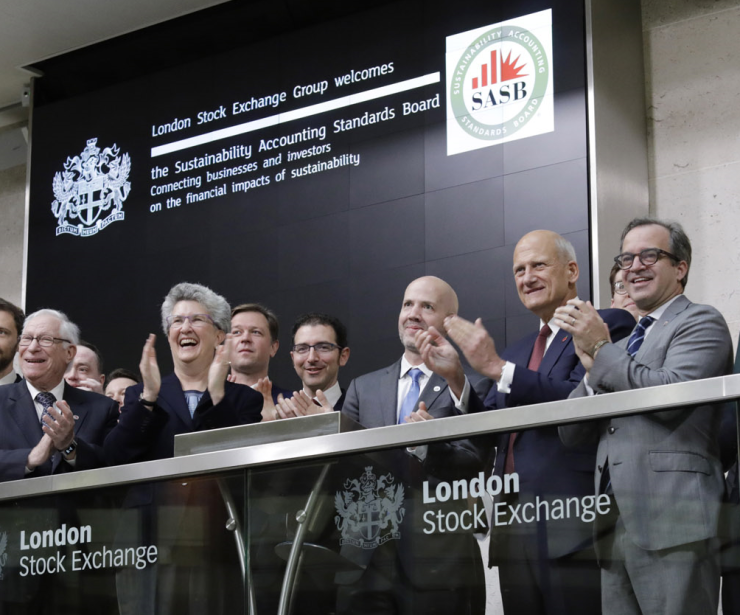The Sustainability Accounting Standards Board and the Global Reporting Initiative announced a collaborative work plan Monday to provide more clarity on how their two sets of standards can be used together for sustainability reporting.
The collaboration comes amid complaints that there are too many conflicting sets of sustainability standards being promulgated, making it difficult for investors and companies to know which ones to follow. SASB and GRI have already been working together as part of the Corporate Reporting Dialogue, an initiative organized by the International Integrated Reporting Council that has been working to bring together the various standard-setters to promote greater consistency and comparability among the different sets of standards and frameworks for non-financial reporting.
The collaboration announced Monday by SASB and the GRI aims to demonstrate how some companies have used both sets of standards together and the lessons that can be shared. SASB and the GRI also hope to help the consumers of sustainability data, such as investors and financial analysts, understand the similarities and differences in the information created from these standards.
“GRI and SASB share the guiding principle that transparency is the best currency for creating trust among organizations and their stakeholders,” said GRI CEO Tim Mohin in a statement. “Investors, policy makers, civil society and other stakeholders are demanding improved disclosure of information on sustainability impacts, including those likely to drive risk and opportunity in both the short and long term.”
The collaboration will initially focus on delivering communication materials to help stakeholders better understand how the standards can be used together. GRI and SASB also plan to develop examples based on real-world reports to demonstrate how the standards can be employed concurrently. These resources are expected to be delivered before the end of this year. The two groups anticipate this will lead to further collaboration opportunities. The two organizations see a need for more environmental, social and governance information especially now in the midst of the novel coronavirus pandemic and afterward.
“In a post-COVID world, companies will increasingly be expected to disclose their performance on a range of ESG topics,” said SASB CEO Janine Guillot in a statement. “The pandemic has demonstrated that so-called ‘non-financial’ information can indeed highlight material financial implications. This makes the collaboration between SASB and GRI, and the increased clarity it will bring for all stakeholders, all the more timely.”
Coronavirus is already having an impact on financial reporting. “What has happened with the current pandemic is that it has rushed forward in a major way an immediate financial impact on a number of issues related to human capital, along with social capital, the health and safety of employees and customers, and a company's ability to actually engage in the work that they want to engage in and what it's like for their customers and employees,” SASB chair Jeffrey Hales recently told Accounting Today. “What we're seeing is huge implications, immediately from a financial standpoint if you just look at earnings releases and the regulatory filings that are happening. There's a larger discussion around it right now. The longer-term perspective is it has helped people to realize that these issues around human capital and social capital need to be managed and there are implications. We're going to continue thinking about it from our perspective at SASB to help us understand where our standards are and where there may be gaps going forward.”
The two groups noted that independence is important to both the GRI and SASB standard-setting processes, and they plan to maintain their independence. This collaborative work plan may identify opportunities to consider how the SASB and GRI standards may be developed in the future. Decisions about standard setting, content of standards, and their interpretation are the sole responsibility of the independent standards-setting functions, which rest with the Global Sustainability Standards Board on behalf of GRI, and of the SASB Standards Board.
GRI and SASB both provide compatible standards for sustainability reporting, but the groups pointed out that they’re designed to fulfill different purposes and are based on different approaches to materiality. SASB’s industry-specific standards identify the subset of sustainability-related risks and opportunities most likely to affect a company’s financial condition (such as its balance sheet), operating performance (such as its income statement), or risk profile (for example, its market valuation and cost of capital). The GRI standards, in contrast, focus on the economic, environmental and social impacts of a company, and its contributions — positive or negative — toward sustainable development. Users of the GRI standards identify issues that are of utmost importance to their stakeholders. If they’re not already financially material at the time of reporting, these impacts can become financially material over time. They provide both the framework and supporting standards on a wide range of sustainability topics and are aligned with international instruments for responsible business behavior.
GRI and SASB said they believe that providing clarity on the application of their reporting standards, and helping others understand how to use the sustainability performance data they provide, is critical to meeting the needs of all stakeholders.






